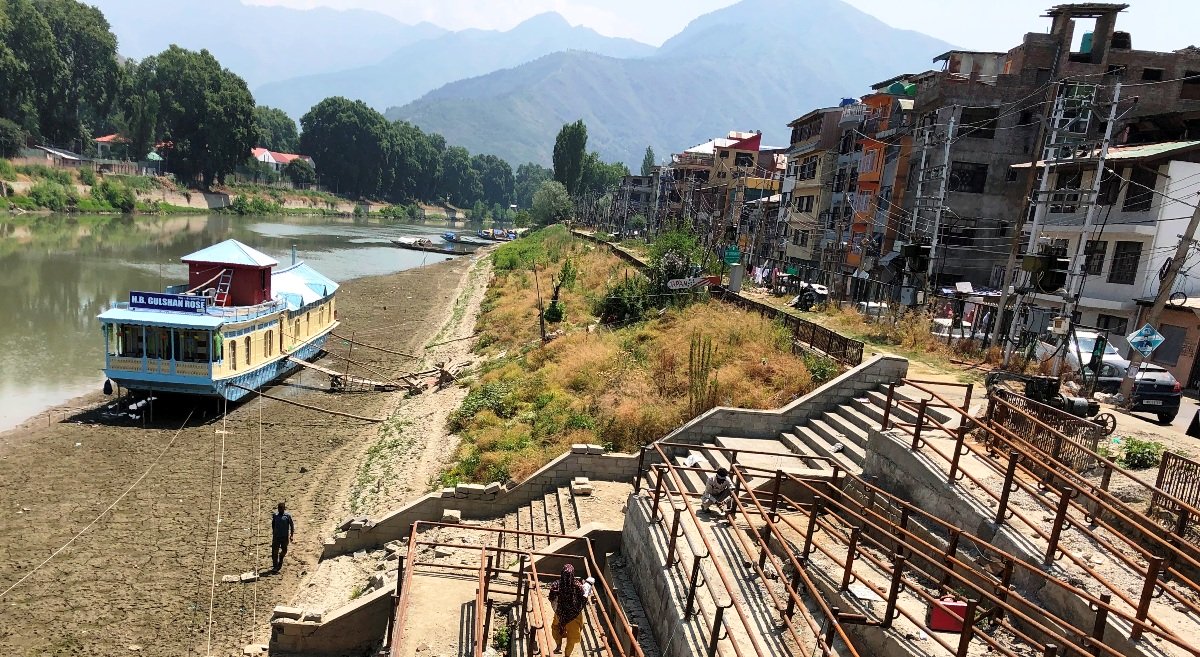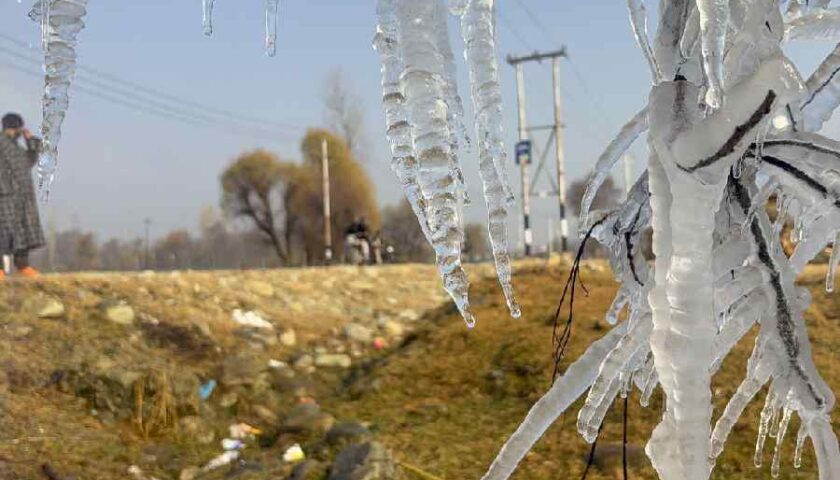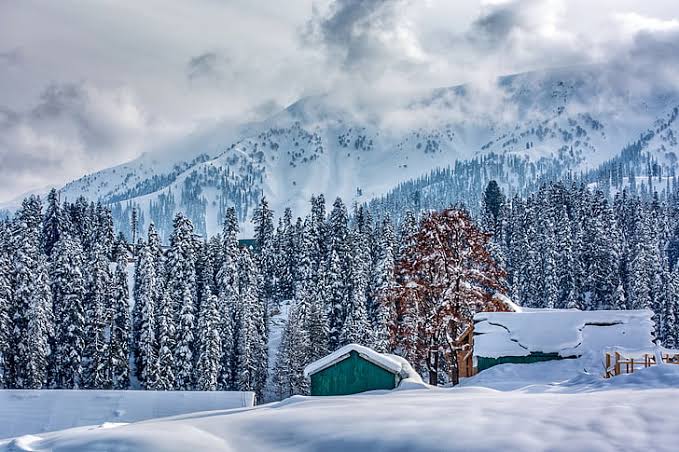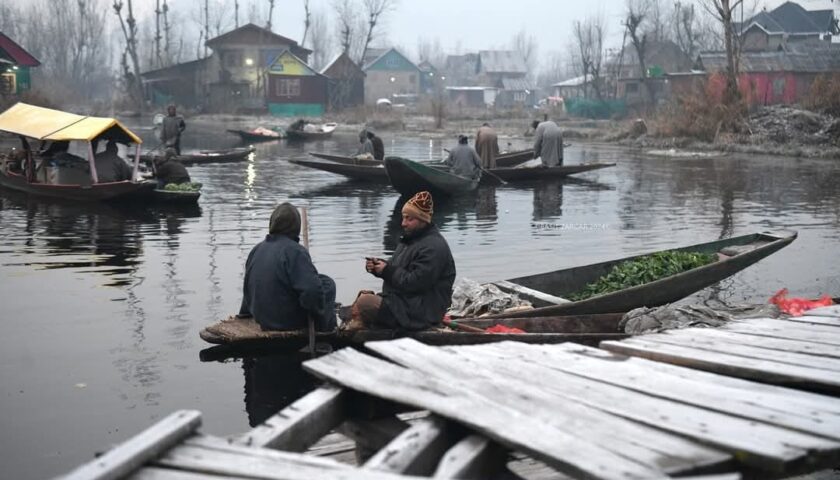Kashmir’s Jhelum Hits 5-Year Low: A Climate, Environmental & Humanitarian Emergency
By: Javid Amin | Srinagar | 03 July 2025
When the River That Fed Millions Feels Empty
The Jhelum River, the vital water artery that has sustained communities, farms, and ecosystems in Kashmir for centuries, is today sounding an alarm. On June 30, the river’s gauge dropped to just 0.57 feet, marking its lowest level in five years—a chilling sign that climate change is no longer on the horizon; it is here.
This article delves deep into the factors driving this crisis, the devastating impact on agriculture and urban life, the environmental consequences, and what must be done immediately—and for the long term—to avert catastrophe.
What’s Causing the Collapse?
01 Prolonged Dry Spells & Precipitation Deficit
Kashmir has seen five consecutive years of below-normal rainfall, with 2024 recording the lowest in 50 years . In some areas, precipitation dipped more than 38% in critical winter months, starving the snowpack that feeds rivers.
02 Ravaging Heatwaves Amplify Evaporation
June 2025 was the hottest June since 1978, with 35.5 °C recorded in Srinagar—surpassing Jammu on several days . This extreme heat accelerated evaporation, further shrinking river flow.
03 Retreating Glaciers Reduce the Lifeblood
The Kolahoi Glacier, the main feeder to Jhelum tributaries like Lidder Nallah, has lost 23–30% of its mass in recent decades, retreating 16–18 m annually, sometimes up to 73 m/year, depending on measurement methods. With each melt season, the glacier offers less and less relief.
04 Disappearing Tributaries
Streams such as Lidder Nallah, Rambiara Nallah, Lal Koul, and Ferozpura Nallah have dried completely by early summer, cutting off irrigation to over 40,000 kanals of farmland .
What’s at Stake?
01 Irrigation & Food Security
With 40,000 kanals of land going dry, giant swaths of paddy, pulses, and orchard farms risk collapse. The state’s self-sufficiency in rice and apple production is entering existential danger.
02 Urban Water Scarcity
Residents in Srinagar report water supply as low as 30 minutes per day, prompting urgent demand for tanker services. Municipal water systems are failing under pressure.
03 Ecological Distress
Dry rivers destroy aquatic habitats, reduce fish stocks, and devastate wetlands. Reduced flow amplifies pollution levels and harms biodiversity.
04 Human Health Risks
When urban water systems run dry, people resort to unsafe groundwater—risking waterborne diseases like cholera and dysentery. Lower water volumes also mean higher concentrations of pollutants.
Voices from the Valley
“In my 60 years, I’ve never seen anything like this. We’re at the end of our hope.” — Sagipora farmer
“We collect water in buckets every night just to cook and wash.” — Srinagar homemaker
“No irrigation, no crop. Loans hang over us, farms wasted.” — Anantnag orchardist
These are not isolated complaints—they echo across villages, towns, and valleys—and reflect a regional breakdown in water security.
The Bigger Problem: Patterns & Trends
01 Long-Term Decline
Studies show a statistically significant drop in Jhelum’s average and peak discharges over decades.
02 Climate Models Warn of More Extremes
Forecast models indicate temperature increases of 0.36–1.48 °C and precipitation decreases up to 6.6% by 2080s under current emissions scenarios . Climate envelopes reveal a shift from smooth supply to unreliable extremes—prolonged droughts and erratic floods.
03 Glacier Loss Will Reduce Summer Flow
Once glaciers recede, initial melt surges give way to steep drops in river flow. Projections show summer water supply from glaciers in the Hindu-Kush region could decline by up to two-thirds.
What’s Being Done—and Why It’s Not Enough
01 Emergency Measures
-
-
Jal Shakti dispatches tankers across cities
-
Streaming water for 30 minutes daily in most zones
-
But departmental officials admit that — “infrastructure is critically overstretched.”
02 Contingency Talks, Not Fixes
Authorities have spoken of installing pumps, auditing irrigation systems, and monitoring glaciers. However, no emergency crop support or large-scale infrastructure funding has been released. Reliance on tanker water remains short-term.
03 Temporary Hope, Long-Term Damage
The rain forecast from July 5–7 may replenish reserves briefly—but experts warn that crop damage, heat stress, and groundwater depletion already inflicted irreparable harm .
The Human Impact
01 Agricultural Collapse
Paddy failures in Anantnag, Sopore, Pulwama and orchard threats are forcing farmers to skip sowing or switch crops hastily—jeopardizing incomes and food affordability.
02 Rural Distress
Borewell owners sell precious water for Rs 4,000–6,000 per tanker. Farm families face months of hardship, accruing debt and suffering deeply.
03 Urban Equity Challenges
Water scarcity becomes a class issue. Lower-income neighborhoods with fewer borewells or tankers suffer more disruption and health risks.
04 Environmental Degradation
Dry conditions compound soil erosion, salt intrusion in farmland, and reduced groundwater recharge—undermining long-term sustainability.
What Needs to Happen Now
01 Emergency Water Management
-
-
Large-scale drilling of solar-powered tube wells
-
Community rainwater harvesting and retrofitting
-
Tanker subsidies for the poorest zones
-
Groundwater recharge through managed aquifer recharge (MAR)
-
02 Climate Adaptation & Mitigation
-
-
Formal glacier monitoring programs with local participation
-
Mass afforestation in upper catchments
-
Drip irrigation plus mulching in orchards and farms
-
Crop switching: Drought-resistant, low-water pulses
-
Climate-resilient greenhouses for high-value horticulture
-
03 Governance & Awareness
-
-
A real-time water-level dashboard
-
Coordination across Jal Shakti, Agriculture, and Environment departments
-
Village WASH committees for community-led water management
-
Public campaigns on water conservation and groundwater protection
-
Lessons from Other Regions
-
Himachal Pradesh’s micro-watershed revival restored village water access
-
Israel’s drip irrigation adoption in arid highlands
-
Australia’s rainwater catchments fetch long-term groundwater stability
Each provides practical inspiration tailor-made to Kashmir’s terrain.
Bottom-Line: Crisis Becomes Change
The Jhelum’s plunging water levels aren’t just a seasonal anomaly—they mark the arrival of a regional climate revolution. Failure to act swiftly risks Kashmir’s agriculture, ecology, public health, and future.
But action is still possible—with clear leadership, urgent funding, and community mobilization, Kashmir can redirect this crisis into a blueprint for climate resilience.
For the River Jhelum, time to act is running short. Let this moment usher a new era—where empty taps and dry streams give way to green fields, restored glaciers, and flowing lifelines.
Quick Snapshot: Crisis & Response Matrix
| Issue | Immediate Impact | Urgent Response | Long-Term Strategy |
|---|---|---|---|
| Jhelum = 0.57 ft | Irrigation failure, urban tap rationing | Tankers, solar wells | Watershed recharge, drip systems |
| Glacier retreat | Reduced summer flow | Monitor glaciers | Afforestation, catchment protection |
| Heatwaves | Stream evaporation | Shade nets, mulching | Crop diversification |
| Precipitation ↓ | Wet season drought | Rainwater harvesting | Climate-resilient agriculture |
| Governance gaps | Poor inter-agency action | Dashboard + relief funds | Institutional coordination |




